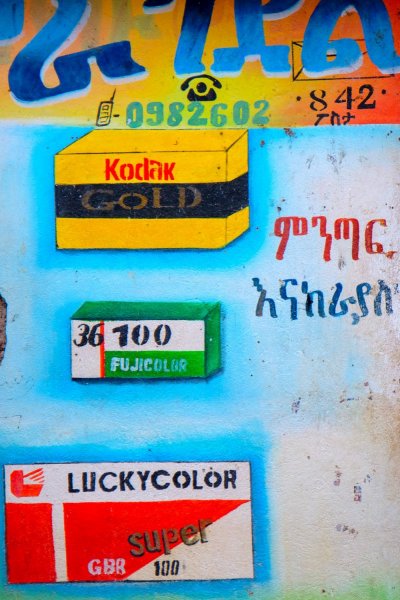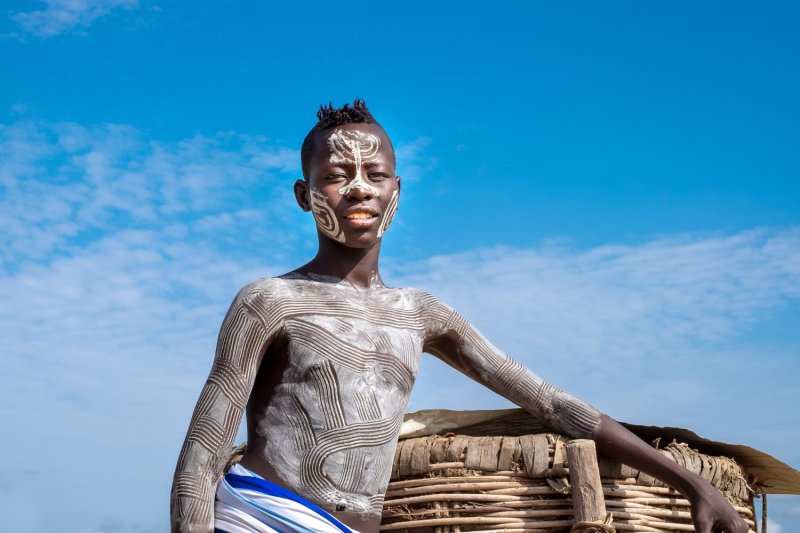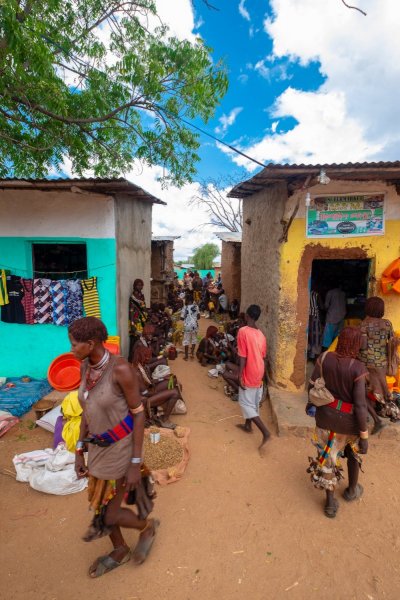Seeking to wander off the beaten path, I was about to enter the Omo Valley on a sunny day of December 2018…
But let’s backtrack a little to explain the initial context.
After roughly two weeks roaming around the Oromia Region (click here for some pics), strolling through the coffee plantations, bonding with local people, exchanging with farmers or fooling around with kids, and after a 3-days stop in Addis to cover the last steps of the coffee processing (dry mill, Ethiopian Coffee Exchange and export), a new adventure was about to begin.
After several intense months (last time I had like a straight week free was in Spring 2017) it was time for me to tak some time off and to reward myself with something I had dreamt about for quite some time, i.e. a (road) trip to the lower Omo Valley to meet the native tribes.
As usual, my friend Girum fixed me with a great program and an even greater driver/guide.
The road book/agenda looked the following (not necessarily in that order though):
- Ziway
- Shashamene (Rastafari)
- Awasa
- Dorze Village / Dorze Tribe
- Konso Tribe
- Turmi
- Karo Tribe
- Hamer Tribe
- Jinka
- Mursi Tribe
- Banna Tribe
- Lake Chamo
- Arba’Minch
The images are still clear in my mind, the itinerary a bit less. But should you be interested in going on the same adventure, hook up with my man Girum (travel agency website here), he will organise EVERYTHING for you. Word!
On a Saturday morning our driver, Habtamu aka the BOSS, came to pick Raul (my fellow traveler) and myself up. And so we hit the Ethiopian « massage » roads as they like to affectionately call them. Sweet euphemism if you ask me, but definitely worth the “pain” as I could shot some of the best portraits ever.

Woman with lip plate, Mursi Tribe
Now, if I had to sum up what makes this region so special and why I chose the Omo Valley (over other options like Lalibela or Gondar), I’d say, besides the fact that UNESCO has named it World Heritage site (for a good reason), you can meet firstly over a dozen tribes, coexisting with a variable degree of peace.
Should you be interested to learn more about the different tribes, their habits and customs, etc. I would suggest you to look up this Atlas-of-Humanity website (click here). I found it quite to the point.
Then, in term of landscape, you can also expect a mulitifarious scenery. I was traveling at the end of the rainy season (December), so the vegetation was really green. We drove also trough a dry savannah expense on our way to the Karo tribe (Turmi, lower Omo Valley), but the cactus were in blossom, so a really unique spectacle.

50 shades of colors
The topography is also very changing. It is relatively flat in the upper Omo Valley, where you can find the big lakes (Chamo, Awasa, Ziway) and many big farms, cultivating vegetables/flowers for European markets, cattle for India and Cotton for Turkish clothing manufactures (the proximity with the lakes for the irrigation is an explanation).

On our way to the Mursi
In other areas, the topography is rather mountainous. The Bale Mountains National Park is a great spot for trekking lovers, as it is still located outside the well-known trekking routes. The region boasts several indigenous species like Ethiopian wolves, hyenas, lions, monkeys, African leopards, etc. So if you want to spot wildlife in a still relatively well preserved environment, the park is a must do.

Sleepy Croco on Lake Chamo
Last but not least, the region is special because it is still preserved from mass tourism…to a certain extent. Tripping in the Omo Valley is relatively costly (around 100-200$/day/pers., depending on your bargaining skills and the size of your group). The costs for the driver/car make up a big part of the expenses.
You can try to do part on a budget (with public transportation). Though, if you want to reach remote villages, you will eventually have to hire a private car or join an existing group. So charter/big groups are not very common.
Finding accomodations in big towns (Jinca, Awasa, Arba’Minch) is also not a big problem, even if in some areas, options might be limited. Prices vary according to quality and some top-notch hotels/lodges are definitely worth a visit.

Sunset over Lake Chamo @ Arba Minch Paradise Lodge (what a treat!!)
Yet, tourism in general and big infrastructure projects (Gibe Dam III, paved roads which makes it easier for tourists to travel, etc.) have already affected the daily life of the tribes, which in turn becomes slowly a fancy dress parade for tourists (this article depicts the phenomenon very well, click here).
Concretely, people in certain tribes will paint their body/face normally only for certain occasions for example. Or Mursi women will wear their lip plate when they have guests at home (more info here). However, they are smart and they realised that the demand was there (tourists craving for the 1000-likes IG snap), so they had only to come up with the matching offer.
The result is a procession of 4x4s, stopping in the villages, a flow of tourists snapping around for 5mins on a 10 bir (40cts) per picture basis, and leaving the premises as fast as they came.
So on the plus side, it means more money for locals, money given directly to the locals without middlemen putting their fingers in the till. It can represent additional revenues for families, who live objectively in rough conditions.
Another upside results in a relatively lower consumption of alcohol and Khat (an indigenous psychotropic plant) I was told, as men try to be on their best behaviour to welcome the tourists and to cross-sell: the bundle lip-plate and picture was a hit! Flair for good service you said :-)?

The Karo Tribe, famous for their body/face paintings
But on the down side, an erosion of habits and traditions is inevitable. How do you expect locals to stick to their traditions when they can make several times what they earn on average with a few pictures. Hence, kids/women will charm tourists with their best formal dresses/pomp.
Is there also a drop in school attendance (in tribes where kids do go to school)? I haven’t come across any statistics denying or affirming this hypothesis but one can wonder…
So does it mean you shouldn’t visit the Omo Valley?
The answer is crystal clear in my opinion: you should definitely visit.
Firstly because it is terrific and people are amazing. Secondly, tourism, if done in a responsible manner, can also be beneficial.
A good case study would be the Dorze tribe. They managed to streamline the flow of tourists and to involve the whole community. Basically, when you visit the village, you pay an entry fee that grant you full access to the people/village. So you can take as many pictures as you want for ex.. And the local committee will then make sure that everybody gets a fair share of the revenues generated. It is one possible best practice, among many others.
In other tribes, it is a bit different. Basically you are required to hire a local « guide » to visit some villages, guide who is supposed to lead you throughout the village and provide explanations, and of course pay each photo. Or you pay some sort of an “all-you-can-snap” fee to the village leader. Quite convenient as you don’t have to bargain each picture. However, the level of commitment of the guide is often medium to low and the explanations very basic first, and you don’t know if the chief of the village shares the money and how he does it.
Yet, if I can give you a piece of advice, it would be the following:
- Firstly, do not start off with the snapping when you arrive on site. Keep your camera in your bag for a little while. Start to stroll along innocently.
- Secondly and since you hire/pay for a guide, there is no point not using him. So ask him to stick around to translate your questions. Otherwise he might have an incentive to hang out with his peers.
- Ask villagers basic questions about local habits or basic stuff, e.g. why are the house doors so small?
- Try to bond with the natives by explaining how is it where you live. It might sound obvious but bonding on similarity helps.
- Ask then if it is ok to take a picture at some point if you feel like it (good connection). Of course you will eventually pay for it as well. But the interaction is different and the result on the film roll too as when you just hand over the money and shoot without asking for permissions (and I’ve seen it many times).
- Show them the picture(s) taken and tell them they look beautiful.
- Thank them for their time and kindness. Do it in their dialect and you get a bonus point 😉
Furthermore, from time to time, I also let them play with my smartphone and take pictures. Some were great at taking selfies! They had good fun and I took great pictures.
And, if you spot a photogenic person or groups, ask them to shoot them separately in a nice surrounding. Tell them you will pay a bit more. When you shoot a bit outside from the center of agitation, people tend to be more relaxed and focussed on what you want (sorry but photograph quirk :-). Otherwise, they are just seeking for the next giving hands.
But overall, I have to confess that we got access to authentic people thanks to our driver. Habtamu has been taking travelers to remote villages for many years, actually not only in the Omo but throughout the whole country. He could speak several dialects and was super well connected thanks to previous jobs he did, among others for a French journalist. So we left the beaten path from time to time and met amazing folks.
Only regret, we couldn’t attend to a bull jumping ceremony (Ukuli Bula in local dialect, more here). Albeit jumping ceremonies take place during the first two weeks of December in certain Hamer villages, we had to compromise between several driving hours to see one and the possibility to see another tribe that we hadn’t seen yet. So we went for the second option and were thrilled about it too.
And cherry on top of the cake, we spoted some bull jumpers at a local market. They were strolling around. According to our guide, before a jumping ceremony, they hang out at the market, wearing their best dress to impress the ladies. Recalling that bull jumping is an initiation into manhood, you definitely want to have your female audience all pumped up for the big day!!

Bull jumpers, wearing their pomp at the market to impress the ladies
And one wish for next time, as I am sure there will be one. Overnight in a village with a tribe. I’ve heard it is possible to camp and you have a whole different experience, as you are on site at dawn when people are busy with their normal life, so 200% authentic. Yet, and this is a general tip for Ethiopia if you want to camp, you should bring your own bivouac gear, as finding (quality or even basic) material is a bit a pain in the rear-end.
So I think this is it for now. Thanks for reading through.
The text is a bit longer this time but I think it gives you a base to understand the pictures, the background of the trip and maybe some tips should you ever want to come and see by yourself.
Now, sit back, relax, hit up the link to set-up the musical ambiance (Mamani Keita – Djekafo) and then click on a picture to start the slideshow.
Bon voyage! Hope you’ll enjoy it!
Take care and talk to you soon.
Adrien
















































